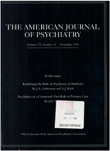Characteristics of psychoanalytic patients under a nationalized health plan: DSM-III-R diagnoses, previous treatment, and childhood trauma
Abstract
OBJECTIVE: This article reports the results of a survey to collect data on the characteristics of patients in psychoanalysis under a nationalized health insurance scheme. METHOD: A questionnaire, to be answered anonymously, was sent to all 174 accredited psychoanalysts in Ontario, Canada. Part 1 of the questionnaire consisted of 38 questions on the analyst's pattern of practice. Part 2, also to be filled out by the analyst, consisted of 452 questions on the demographic characteristics, childhood traumas, DSM-III-R diagnoses, and indications for psychoanalysis of each of the analyst's patients. RESULTS: One hundred seventeen analysts responded--a survey response rate of 67%--with data on 580 patients. Fifty-nine percent (N = 344) of patients were women, and 41% (N = 236) were men. Eighty-two percent had attempted other forms of treatment, including briefer forms of psychotherapy and medication, prior to psychoanalysis. During childhood, 23% had had traumatic separations, 23% had been sexually abused, 22% had been physically abused, and 21% had had a parent or sibling die. The mean number of adult psychiatric disorders at the beginning of analysis was four, and the mode was two. CONCLUSIONS: In a nationalized health insurance scheme, the psychoanalytic patients were mostly women, they had high rates of trauma and psychopathology, and they had attempted other forms of briefer treatment before resorting to psychoanalysis.
Access content
To read the fulltext, please use one of the options below to sign in or purchase access.- Personal login
- Institutional Login
- Sign in via OpenAthens
- Register for access
-
Please login/register if you wish to pair your device and check access availability.
Not a subscriber?
PsychiatryOnline subscription options offer access to the DSM-5 library, books, journals, CME, and patient resources. This all-in-one virtual library provides psychiatrists and mental health professionals with key resources for diagnosis, treatment, research, and professional development.
Need more help? PsychiatryOnline Customer Service may be reached by emailing [email protected] or by calling 800-368-5777 (in the U.S.) or 703-907-7322 (outside the U.S.).



